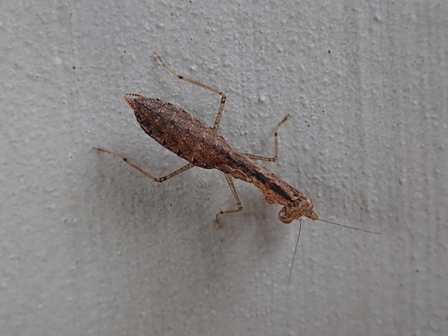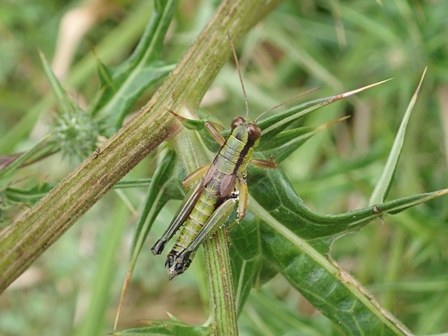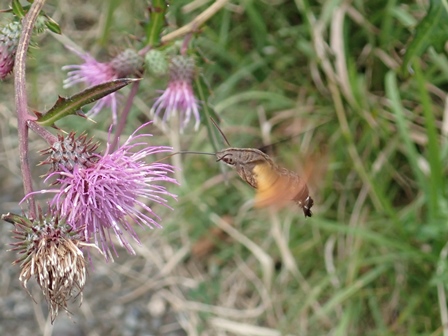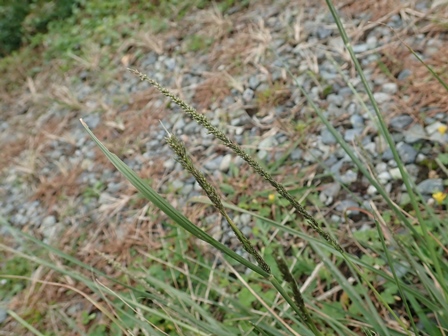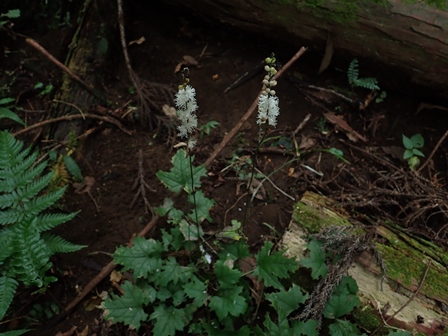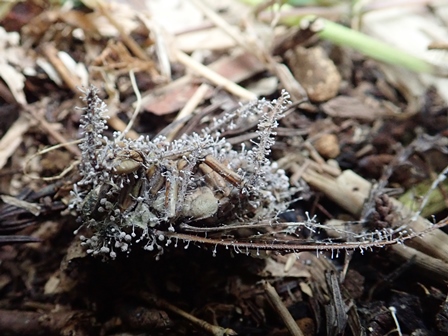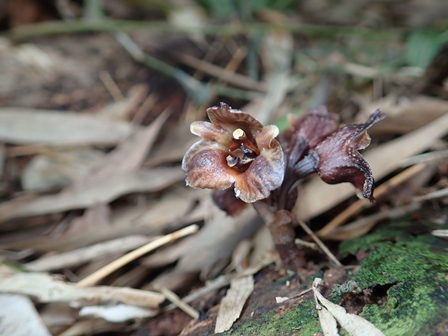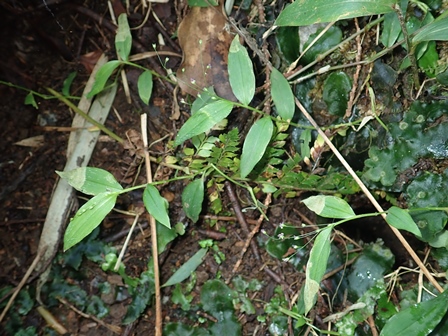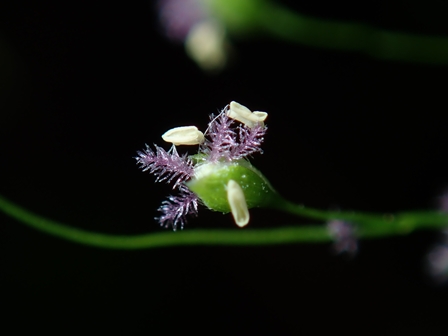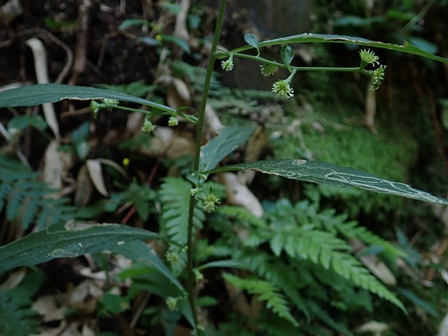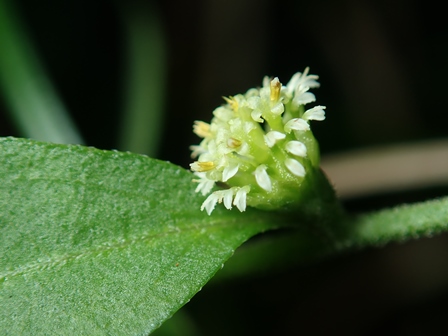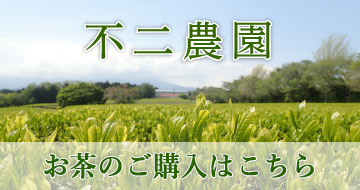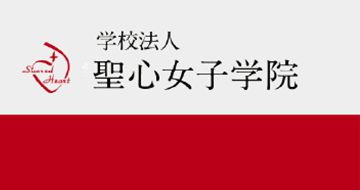フィールド日記
2020年10月
2020.10.30
ヒナカマキリ
講堂の壁にヒナカマキリがとまっていました。その名の通り、2cmにも満たない小さなカマキリです。成虫でも翅が小さいため、まるで、幼虫のように見えます。アリなどの小さい昆虫を捕らえて食べているようです。
I found a "Hinakamakiri (ヒナカマキリ)" on the wall of the auditorium. As the name suggest, it is a small praying mantis. The body is less than 2 cm long. They have small wings, so they look like larvae, even when they are adults. It is said they catch and eat small bugs like ants.
2020.10.27
タンザワフキバッタ
ススキ野原でタンザワフキバッタを見つけました。フキバッタの仲間は成虫でも翅が短いため、長い距離を移動することができず、地域ごとに種の分化が進んでいると言われています。和名は神奈川県の丹沢山地にちなんでつけられていますが、関東から伊豆半島にかけて分布しています。
I found a "Tanzawafukibatta (タンザワフキバッタ)" grasshopper in the Japanese pampas grass field. The grasshoppers in this "fukibatta" group have too short wings to fly even when they are adults. It is said they have been differentiated into various species based on where they live. Although the name comes from the Tanzawa Mountains in Kanagawa prefecture, they live in from the Kanto district to the Izu peninsula.
2020.10.23
ホシホウジャク
ススキ野原でホシホウジャクを見つけました。空中でホバリングをしながら蜜を吸う、スズメガの仲間です。幼虫の食草はヘクソカズラです。
I found a "Hoshihoujaku (ホシホウジャク)" moth in the Japanese pampas grass field. This species is a hawk moth that sucks nectar of flowers while hovering. The host plant of their larva is the "Hekusokazura (ヘクソカズラ)" plant.
2020.10.20
ネズミノオ
道端にネズミノオが見られます。花序は、花のつく枝が中軸にぴったりと沿うため、細長い穂状に見えます。この姿がネズミの尾に見えることが名前の由来のようです。
I found the "Nezuminoo (ネズミノオ)" plants on the roadsides. The inflorescence looks like a spike because the branches with their flowers stick completely to the axis. The name comes from the idea that the inflorescence also looks like a tail of a mouse.
2020.10.16
イヌショウマ
裏道でイヌショウマが咲いています。湿った林縁に見られる多年草で、本州の近畿地方から関東地方に特産します。名前は、生薬として用いられるショウマ(升麻)に似ていることが由来です。
"Inushouma (イヌショウマ)" plants are in bloom in the back road. They are perennial plants growing in the moist edges of forests. They are endemic in Honshu (Kinki district to Kanto district). The name "Inushouma (イヌショウマ)" comes from the fact it's similar to the plant called "Shoma(ショウマ, 升麻)" used as a crude drug.
2020.10.13
セミノハリセンボン
白いトゲトゲがたくさん出ているセミの死がいを見つけました。セミノハリセンボンという菌類に寄生されたセミの死がいのようです。白いトゲトゲは、先端に分生子と呼ばれる無性的に作られた胞子をつける菌糸です。
I found a dead cicada with many white spines. It seemed a dead cicada body parasitized by funguses called "Seminoharisenbon (セミノハリセンボン)". The white spines are hyphae that produce spores on the top, which are called conidia reproduced asexually..
2020.10.09
クロヤツシロラン
竹林の林床でクロヤツシロランが咲いていました。光合成をせず、地下で菌類から栄養を奪って生きているランの仲間です。静岡県では準絶滅危惧種に指定されています。花は褐色で地面から数センチのところに咲くため、気をつけないと見過ごしてしまいますが、果実の時期には、茎が急速に伸び、目立つようになります。(2018年に確認された果実の記事は【こちら】)
A "Kuroyatsushiroran (クロヤツシロラン)" is in bloom on the bamboo forest flooor near the Kyoseinomori-Forest(共生の森). This is a kind of orchid that does not photosynthesize, but takes nutrition from fungi underground. "Kuroyatsushiroran (クロヤツシロラン) " plants are designated as near-threatened species by Shizuoka prefecture. If you do not pay attention, you might not notice them because their flowers are dark brown and bloom above only a few centimeters from the ground. However, their fruits rapidly grow up to 20 cm to 30 cm and become outstanding.
2020.10.07
9月の野鳥の調査
日本野鳥の会東富士副代表の滝道雄先生が9月の不二聖心の野鳥について調査をしてくださいました。調査の報告書が届きましたので、掲載いたします。
2020年9月度の調査で確認された野鳥は下記の通りです。
1.キジバト…1羽
2.トビ…1羽
3.アオゲラ…2羽
4.ハシボソガラス…1羽
5.ハシブトガラス…5羽
6.シジュウカラ…2羽
7.ヒヨドリ…20羽
8.モズ…2羽
9.メジロ…8羽
10.イソヒヨドリ…1羽
11.イカル…2羽
12.ヤマガラ…4羽
13.セグロセキレイ…3羽
14.コゲラ…1羽
15.ノスリ…1羽
16.エナガ…4羽
17.カケス…1羽
18.ソウシチョウ…4羽
19.ガビチョウ…2羽
20.コジュケイ…1羽
【特記事項】
1.台風一過の晴天日に調査したので、秋の渡りをするワシ・タカ類の出現を期待していたが結果は留鳥のトビとノスリの確認にとどまった。
渡りをする蝶として有名なアサギマダラ2頭を第二オークヒル奥のクヌギ林で見つけた。アザミの花の蜜を吸う姿が優雅に見える。愛知県の伊良湖岬に行き、ワシ・タカと一緒に上昇気流に乗り宮古島などを目指す。
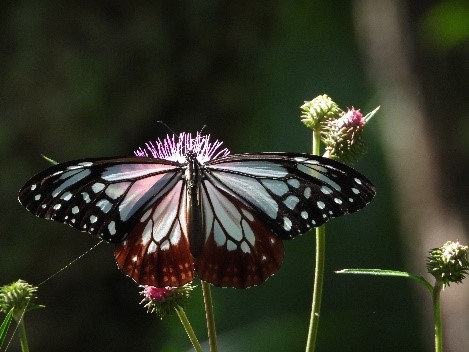
2.秋の訪れを感じさせるモズ、カケスが見られ、繁殖を終えたメジロ、コゲラ、エナガ、ジュウカラの混群が見られるようになった。
3.聖心橋辺りでよく見られたイソヒヨドリが正面玄関の塔にまで進出して来た。
2020.10.06
ハイチゴザサ
ヒノキ林の林床でハイチゴザサが咲いています。湿った林床に生える多年草です。名前の通り、茎の途中から根を出しながら、地面をはうように成長します。
小さくて目立たない植物ですが、花を拡大すると、ピンク色の柱頭がきれいです。
"Haichigozasa (ハイチゴザサ)" plants are in bloom on the Japanese cypress woodland floor. They are a perennial plant on moist forest floors. The name means "small bamboo grass crawling on ground". "Haichigozasa (ハイチゴザサ)" plants literally grow on the ground with their stems holding their roots and look like a small bamboo grass.
The plants are not outstanding because they are small, but when you look closely at their flowers, their pink capitals are beautiful.
2020.10.02
シュウブンソウ
ヒノキ林の林床に、シュウブンソウが咲いていました。和名は、秋分のころに咲くことに由来します。
他のキク科と同様に、たくさんの花が集まって1つの頭花をつくっています。
ヒマワリと同じように、筒状花のまわりに舌状花が並んでいますが、舌状花の花弁は小さいためあまり目立ちません。
"Shuubunso (シュウブンソウ)" plants are in bloom on the Japanese cypress woodland floor. "Shuubun (シュウブン)" in its name refers to the autumnal equinox and it comes from the fact that they bloom around the autumnal equinox.
The same as other chrysanthemums, many small flowers make a head flower. Ligulate flowers surround tubular flowers like sunflowers, but they are not outstanding because the petals of ligulate flowers are small.
- 1 / 1


